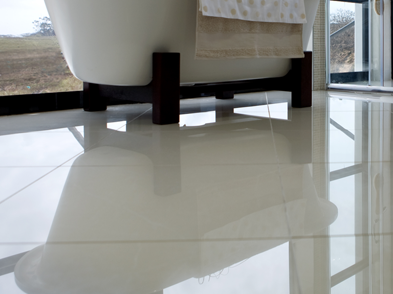The Difference between Porcelain Tiles & Ceramic Tiles
 Porcelain tiles are also ceramic tiles. They are a specified form of ceramic tiles, Porcelain tiles are made from finer, denser clay and fired at far higher temperatures than ceramic tiles. This manufacturing process results in porcelain tiles having a water absorption rating of less than 0.5%, while ceramic tiles have a water absorption of more than 0.5%. Because of this very low water absorption porcelain tiles are also referred to as ‘vitrified’ tiles.
Porcelain tiles are also ceramic tiles. They are a specified form of ceramic tiles, Porcelain tiles are made from finer, denser clay and fired at far higher temperatures than ceramic tiles. This manufacturing process results in porcelain tiles having a water absorption rating of less than 0.5%, while ceramic tiles have a water absorption of more than 0.5%. Because of this very low water absorption porcelain tiles are also referred to as ‘vitrified’ tiles.
This composition makes a porcelain tile more homogenous, dense, durable and much stronger making them ideal for heavy and high traffic areas. Porcelain tiles are also less prone to moisture absorption and staining, and are more scratch-resistant than most ceramic tiles.
Their extremely low porosity makes them ideal for locations with extreme moisture/humidity, as well as freeze/thaw conditions. Not all ceramic tiles can be installed at locations with freezing weather, due to the likelihood of moisture freezing inside the tiles. Internal freezing causes the moisture to expand as it freezes, which often manifests as cracks in the tile. A porcelain tile is less porous and therefore less prone to cracking.
There are various types of porcelain available, namely full-body (also referred to as unglazed or through-body) porcelain (clay body colour consistent right through the tile), glazed porcelain (glaze, usually coloured, applied during the manufacturing process), and double loaded (made by fusing together two layers of different clays during firing). Full-body porcelain can be supplied as matt, polished, textured or nano—finished.
Because of the nature of the porcelain tile body, ie very low water absorption rate and dense body, an adhesive with far stronger bonding characteristics than an unmodified conventional (standard setting) cementitious adhesive is required to install these tiles. Also, due to the impervious nature of porcelain tiles, a standard-setting) adhesive system will take longer to cure.
As such, only high-strength rapid- or quick-setting adhesives, such as TAL GOLDSTAR 6 or TAL GOLDSTAR 12, should be used when installing porcelain tiles to minimise the risk of installation failures. If the tiles are disturbed (trafficked) before the adhesive has set sufficiently the adhesive bond may be broken, resulting in hollow-sounding and/or loose tiles. This is especially important in fast-track installations.
[Back]
blog comments powered by Disqus

